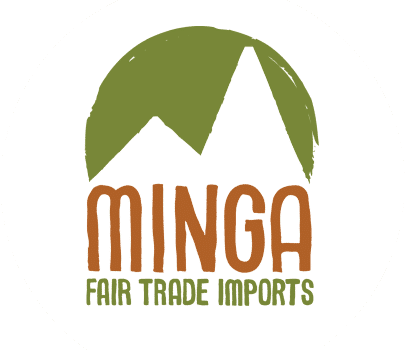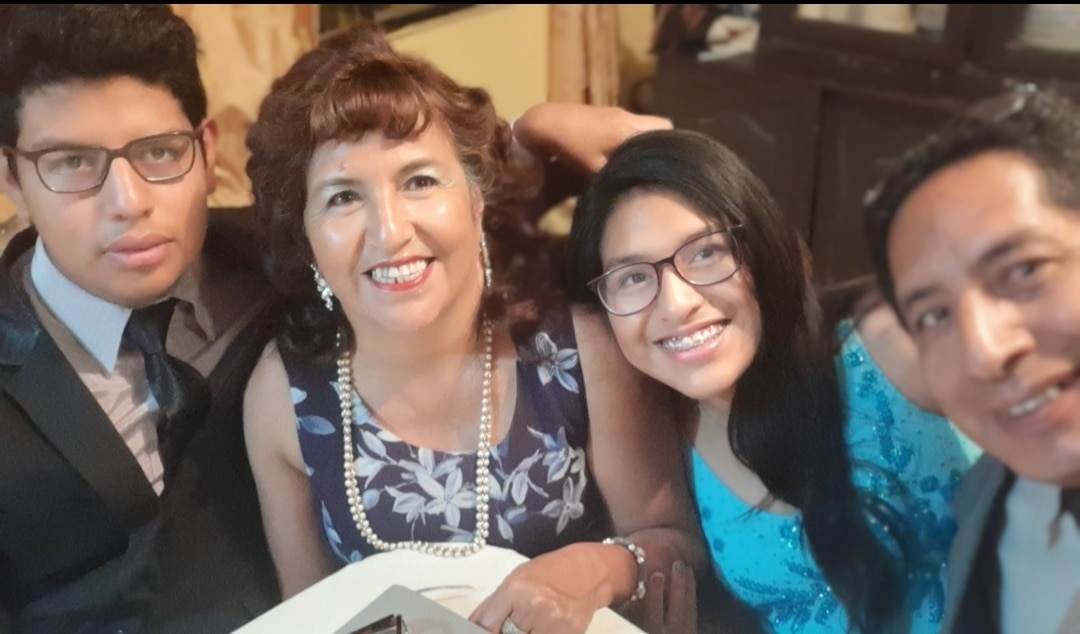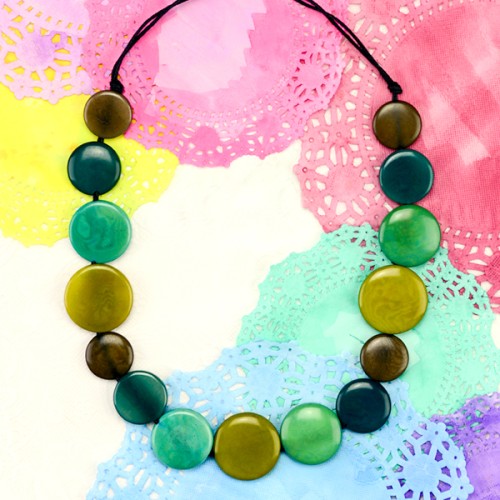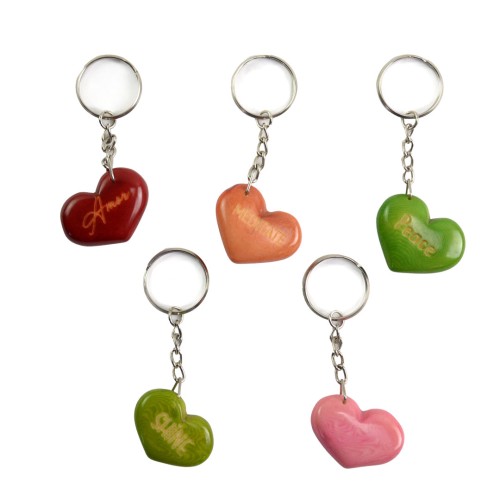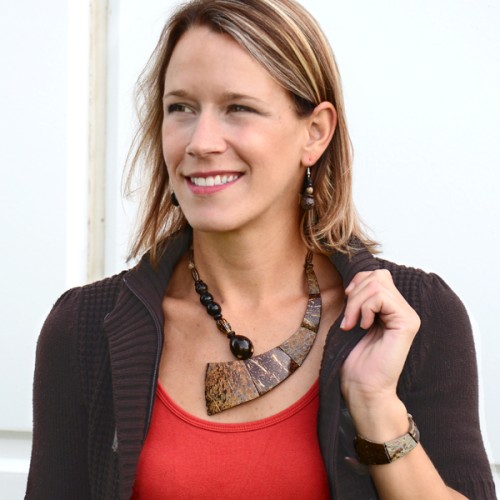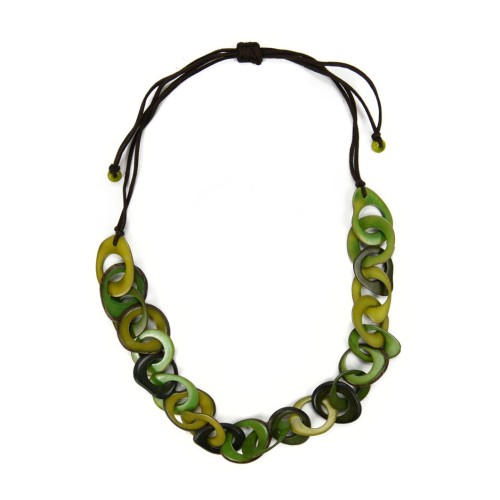Working with Minga since 2006
Workshop: Ecuador
Products: Jewelry-Tagua
Andrés and Juanita were both born in 1964 and have been married for 30 years. They have two children, Mateo and Emily, both in elementary school. Andrés parents worked in tagua in Riobamba, where he was born. In 1985 when Juanita married him, his parents taught her the craft of working in tagua. She learned how to create designs with tagua beads and also to paint them. They worked together as a family making tagua jewelry and selling it for about a year. Then Andrés father fell sick with diabetes.
He needed many visits to the doctor, but they were living on the coast, more than three hours from Quito, where the doctors were. They needed a place to stay. Andrés brother had a shop at the plaza where the monument showing the equatorial line is so he sold it to them, they rented a house (which they later owned) and for five years welcomed his parents on a regular basis for doctor visits. His father died then, and his mother moved back to Riobamba where she still lives and still makes tagua jewelry for sale there.
At first, the business was tough, but it has gotten better and better as she has been able to sell to Minga and other fair trade businesses as well as the tourists. Initially she had several women working in her home, but it was very hard to maintain her home and supervise so many women, so currently, most of the artisans work from their own homes.
They have several employees, Isabel, who works at the shop and also makes jewelry at home, Rosita, Paulina, and Monica, all of whom work at home on the various designs. Isabel is a very gregarious woman who seems like a girl in her 20’s until she tells you how many children she has and how old they are. She’s known Juanita for eight years, worked with her for six. Sarita, Isabel’s daughter, has a severe case of asthma, so it is crucial her mother works to support her.
Working in the shop next door is Yadira, who only helps out for the company, as it is too boring without customers all day. They all say because of the worldwide economic downturn, there are not nearly as many visitors now as once there were. Juanita says that without her fair trade customers, the business would not have survived. Before the crash, people used to pay the prices, considering them quite reasonable. Now, what customers she has are always asking for a discount, always bargaining for a lower price. Nevertheless, the business is doing well. Juanita is a smiling, relaxed woman, extremely hospitable and kind. She is learning English to help her in the shop with foreign customers. It is not hard to see that her happiness is contagious. The mood of the women working on the patio outside the shop is festive, with many jokes and smiles, although their hands never stop moving. As people walk by, they invite them into the store, though only a few accept some days.
They make about 100 different products every year. Each year they add 20 new ones and drop eight or so. The best-selling one is the tagua chip bracelet. It is also one of the best-selling products for Minga. Of the tagua animals, they say the tortoise, the elephant and the owl are the best-selling. Eduardo is the gentleman who carves the animals. He calls himself McGyver because he is so creative, and always making something out of the materials around him. Besides Eduardo, there are seven or eight suppliers of the materials needed to make the jewelry. These parts come already dyed, polished and shaped into the desired form. They order by color and shape, type of material and so forth. It is very hard to get some parts (such as hypoallergenic earring hooks) here in any quantity, so Minga helps them acquire those. Juanita hires outside workers to make the batiked tagua beads and the women put all of these different beads together into various designs. Beads are dyed with both natural materials and synthetic dyes by the bead makers they buy from.
When asked what inspires their designs, Andrés says most of their designs are inspired by design suggestions from clients. Juanita is able to look at a design in a different material and translate it into tagua, such as the tagua chains.
Juanita says her children are still too young to know if they want to continue their family business as artisans when they finish school – sometimes they are interested, others bored.
What Juanita loves the most is working with the tagua and making color decisions (there are 12 in spring/summer and 12 in fall/winter) and especially loves telling foreigners about tagua. She thinks it’s marvelous that tagua when it is fresh is a delicious food (similar to coconut), very popular on the coast, but when it is hard it can be made into so many things. Isabel also likes working with the tagua because it is natural and because it helps saves elephants’ lives. It has been known as “vegetable ivory” for many years because of its ivory-like qualities when hardened. For Andrés, the best part of the tagua business is, “When they send the check” he jokes. What he really loves is working with women to help them learn new skills and improve their work. That part is very gratifying to him. Andrés is gentle and soft-spoken, a patient and wonderful teacher.
A goal Andrés and Juanita are striving for is to raise the quality of the designs to include materials which have a higher perceived value, such as alpaca and silver, and incorporating them with tagua beads. He would like to use the tagua in such a way that it incorporates semi-precious stones or other enhancements. He would like to make fine jewelry more than costume jewelry. One drawback with this is the difficulty of buying such additions in Ecuador. They are not often made here, (example, hypoallergenic earring hooks, and high-quality metal beads) and importing small quantities is too expensive.
Rev. 02/17/2015
Products by Andrés & Juanita
Showing 1–20 of 98 results
Showing 1–20 of 98 results
